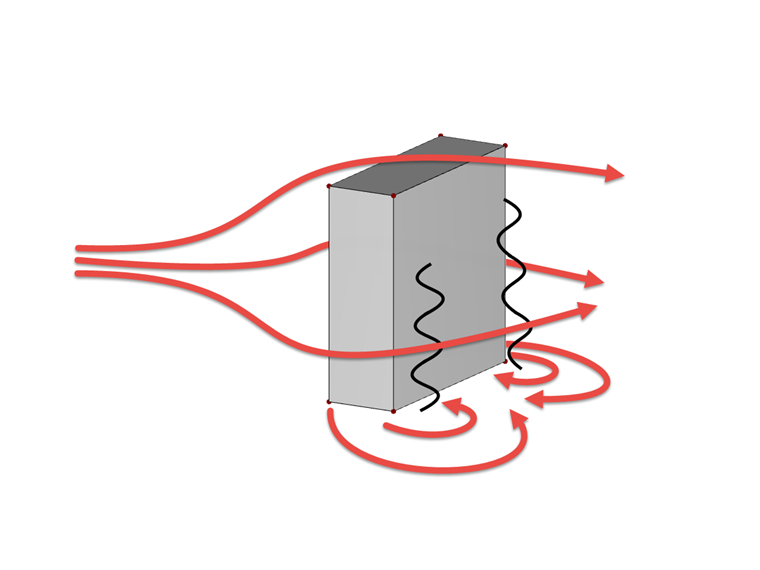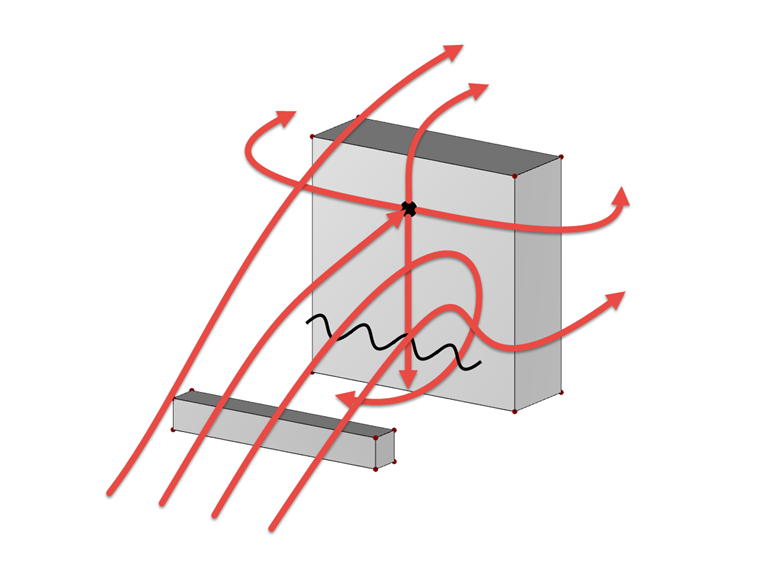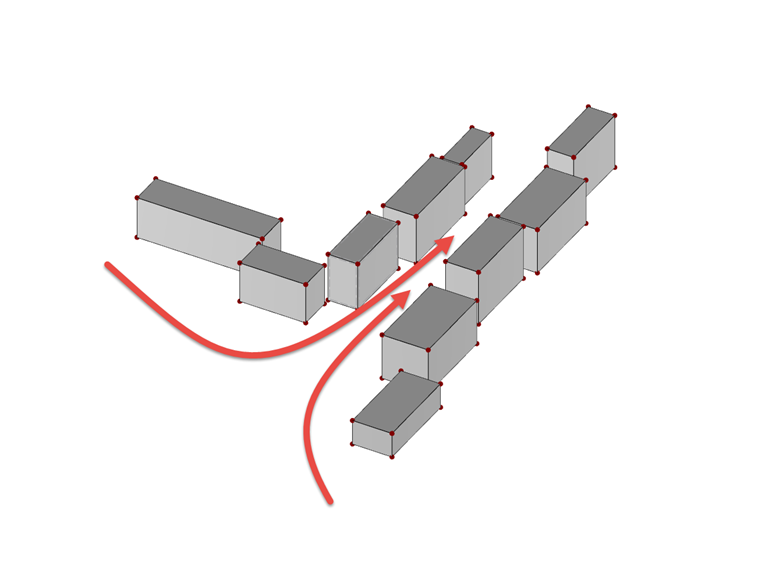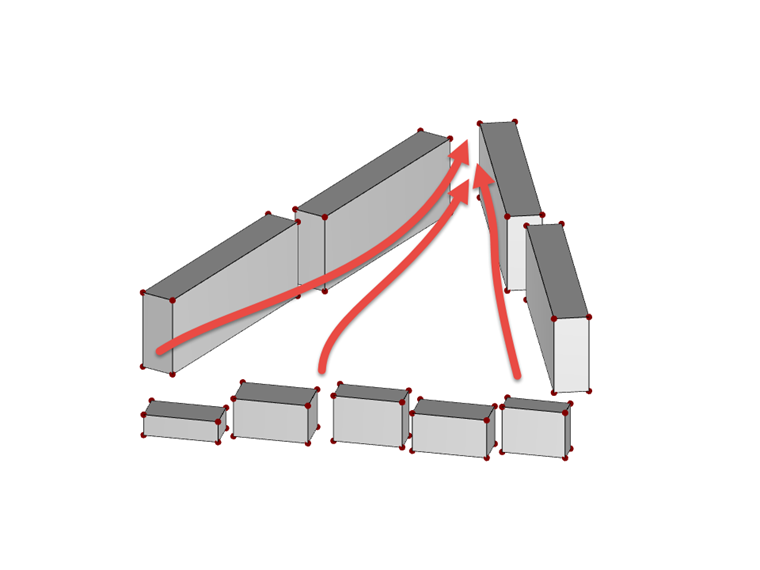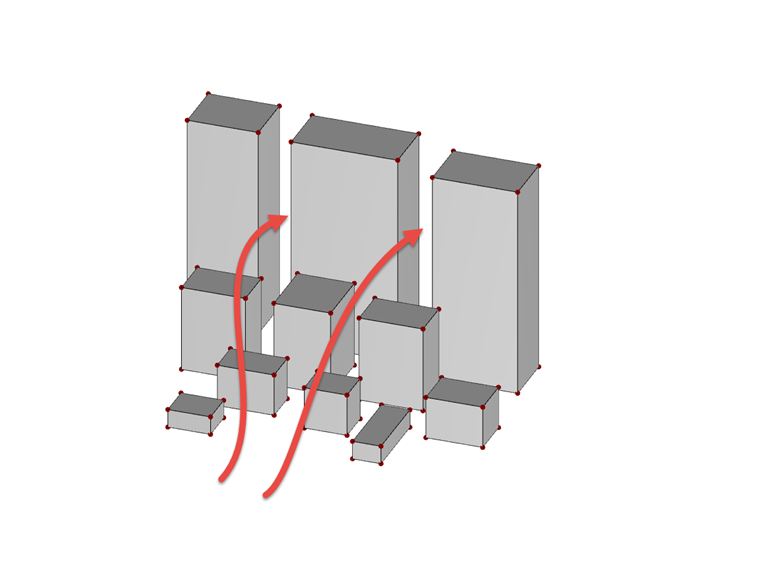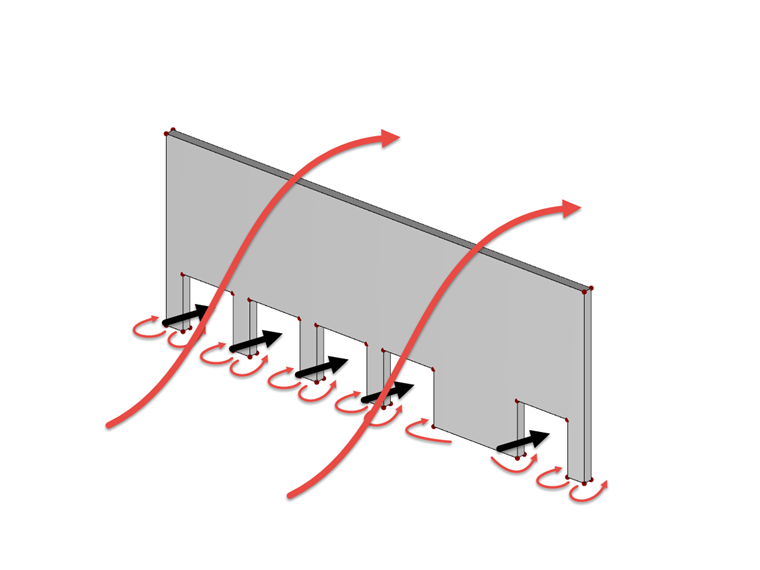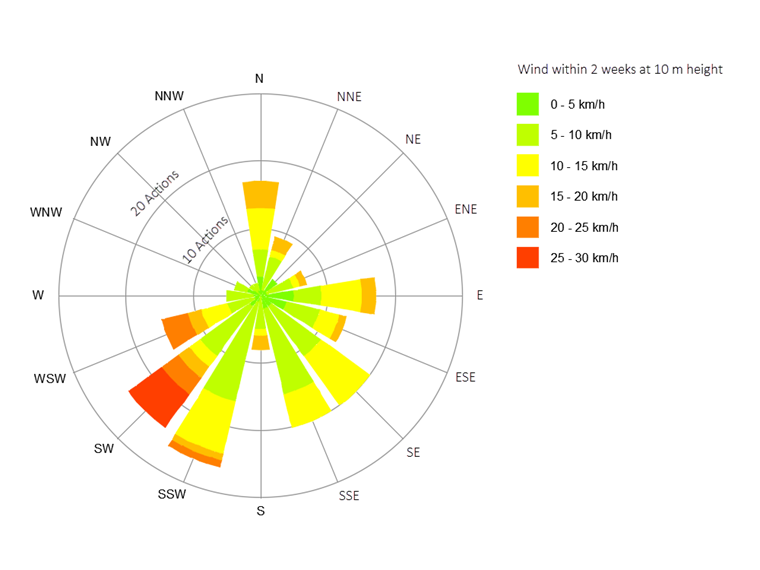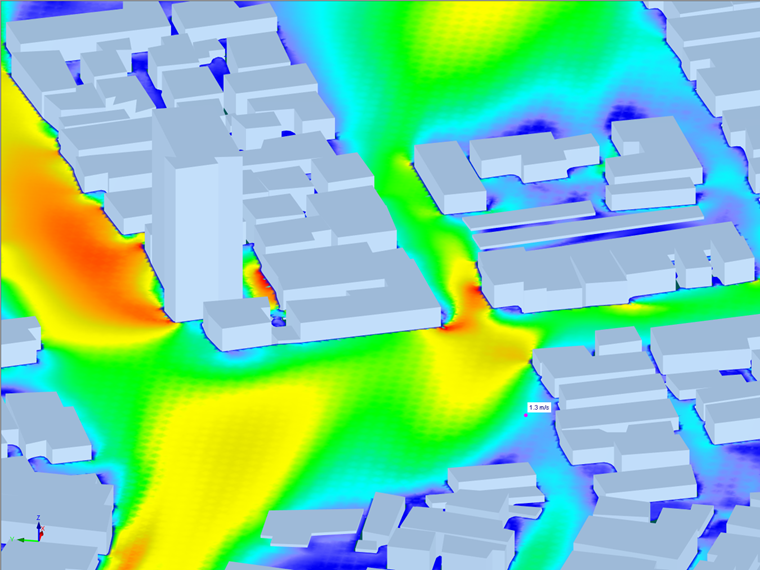In addition, the flow around the building results in a different wind behavior than in the case of a wind flow over undeveloped terrain. Depending on the wind and building properties, this wind behavior has an influence on the microclimate around the building and the people in the surrounding area. In the worst case, staying next to the building becomes unpleasant, with partly hidden dangers for pedestrians and cyclists.
Therefore, in the wind technology related to the construction industry, there is a field that deals not only with the load determination of wind flows around buildings, but also with wind comfort for pedestrians and cyclists next to the buildings.
Possible Flow Influences by Buildings
Buildings not only oppose the wind, but also influence the flow around the building shape [1]. The flow in this close environment develops very differently depending on the wind direction, building shape, and wind property. Typical individual effects are shown below.
A summation of all these effects has an influence on the urban microclimate [1]. The resulting wind transports air, dirt, snow, odors, and heat through the urban landscape, depending on the globally occurring wind, its local acceleration, and its temporal distribution.
Wind Comfort
Locally accelerated wind flows and turbulences resulting from the interaction between buildings and the actual wind flow show the wind situation in the urban area. In the process, turbulence and high wind speeds due to channeling and venturi effects between and next to the buildings cause discomfort to the people there. Primarily, the flow field induces an unpleasant feeling at the pedestrians' head height (1.5 to 2 meters above the ground). In particularly drastic cases, the occurrence of higher wind speeds also creates a risk for pedestrians and cyclists being pushed away by the wind, unplanned.
In order to avert danger from these wind effects and to make the effects reasonable, various criteria have been developed over time. The best-known criteria are the limit values according to Lawson, Davenport and the standard NEN 8100 [2]. The latter standard specifies safety criteria as well as the required comfort criteria.
Wind comfort at a specific location can be estimated with these criteria, using the meteorological data and local wind conditions. The meteorological data in the study area show the occurring wind speeds per direction in their frequency. Such data sets are often displayed in what are called wind roses.
Due to the various flow effects, the global wind flow generates a non-constant flow field in the urban district or building complex under consideration, with sometimes significant acceleration effects next to and between the buildings. Pedestrian wind comfort is then determined by comparing the local wind speeds with the related meteorological frequencies from the underlying global wind flow [2]. The Dutch standard NEN 8100, for example, provides a categorization for the determination of comfort and safety.
| Comfort Category | Mean Wind Speed [m/s] | Probability of Occurrence [%] | Activity | |
|---|---|---|---|---|
|
|
A | 5 | < 2.5 | Sitting long |
|
|
B | 5 | < 5 | Sitting short |
|
|
C | 5 | < 10 | Strolling |
|
|
D | 5 | < 20 | Walking fast |
|
|
E | 5 | ≥ 20 | Unacceptable |
| Safety Category | Mean Wind Speed [m/s] | Probability of Occurrence [%] | Danger | |
|---|---|---|---|---|
|
|
A | 15 | < 0.05 | No risk |
|
|
B | 15 | < 0.30 | Limited risk |
|
|
C | 15 | ≥ 0.30 | Dangerous |
New Buildings Change Wind Setting
In the past, there have been various examples in which new buildings have drastically changed the urban microclimate and the associated wind flow field. In the past, the Flatiron Building in New York and, more recently, the high-rise building at 20 Fenchurch Street in London, known as The Walkie-Talkie or The Pint due to its shape, have been the most prominent examples of an uncomfortable environment. These and other cases showed that when constructing a new building in an existing urban landscape, you have to deal not only with the building itself, but also with the environment. Above all, buildings with a height of 25 m or more can significantly change the wind comfort in the surrounding area, due to newly created vertical wind currents on the facade. The wind conditions of such critical structures can only be improved to a very limited extent afterwards. Improvement measures include optimally placed trees for the deceleration and deflection of unpleasant wind currents.
In order to avoid such difficulties, it is better to know the change of the surrounding wind conditions during the design phase of a new building or a building complex. With this information, it is possible to recognize any unpleasant wind comfort zones even before the construction, and to modify the building shape accordingly. Since these shape optimizations usually have to be performed iteratively, a numerical flow simulation is recommended. This digital method can accurately determine the building shape options to be analyzed without wasting resources and output local wind speeds, taking into account the global wind situation over the urban area. This method can be very economical compared to real wind tunnel tests on a reduced city model body, due to the model steps omitted.
Wind Flow Analysis with RWIND Simulation
RWIND Simulation allows you to perform a numerical flow simulation for such city models. The program can import the sometimes rugged, very filigree city model 1:1 without scaling the size via the VTP (ParaView Poly Data) or STL (stereolithography) interfaces into the numerical wind tunnel. The global wind situation in the urban area must be defined at the wind tunnel by means of a wind velocity and turbulence field that is variable over the altitude. As an alternative, the model can also be imported as a structural analysis model with its global wind properties from RFEM directly into the numerical wind tunnel of RWIND Simulation. RWIND Simulation then meshes the free volume area and determines the local flow field around the model with its stationary solver for incompressible, turbulent flows relative to the SIMPLE algorithm (Semi-Implicit Method for Pressure Linked Equations).
Benchmark example E "Building complexes with simple building shape in actual urban area (Niigata)" published in the "Guidebook for CFD Predictions of Urban Wind Environment" [3] of the Architectural Institute of Japan (AIJ) shows impressively how the new construction of higher buildings affects the local wind flow field in the pedestrian area.
The local wind speed for the west wind load case increases with a global wind speed of 3.93 m/s at the reference height of 15.9 m above the urban area behind the building from 1.3 m/s before the construction to 4.43 m/s. s after the construction. This means an increase of about 3.4 times the wind speed with concomitant deterioration of the wind comfort for the pedestrians on the building forecourt.
With RWIND Simulation, this very meaningful result set has been determined without much input effort, including meshing on a standard computer. With such results, urban planners, project developers, architects, and engineers can infer the wind comfort around a building to be planned.
